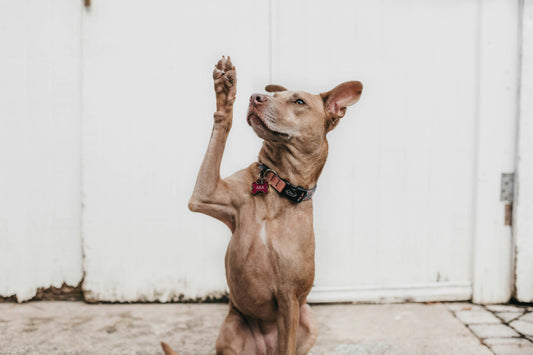Black Scabs on Dogs: Causes, Treatment and Prevention

Key Takeaways
- Black scabs on dogs can indicate an underlying health problem and should not be ignored
- Common causes of black scabs include bacterial skin infections, fungal infections, allergies, and parasitic infestations
- Treatment for black scabs may involve veterinary diagnostics, medications, and home remedies
- Preventative measures such as proper nutrition, skin health supplements, and regular grooming can help reduce the occurrence of black scabs
- It is important to seek veterinary assistance if other concerning symptoms accompany black scabs or do not improve with treatment
It’s common for dogs to get a scab now and then, but if you keep finding black scabs on your dog with no obvious explanation, it may be a sign that something is wrong. You may find scabs clustered in certain places, such as the ears, the belly, or the back. Sometimes dark scabs come with other symptoms, such as balding hair loss, bad smells, or pus. So what causes black scabs on dogs? Are they harmless, or could they signal a much greater problem?
Understanding the causes, treatment, and prevention of black scabs on dogs is important for every dog owner. By recognizing the underlying causes and taking appropriate measures, you can help ensure the health and well-being of your furry friend. In this article, we will explore the various factors that can contribute to the development of black scabs on dogs, as well as the treatment options and preventative measures you can take to keep your dog’s skin healthy and free from scabs.
Understanding Black Scabs on Dogs
Black scabs on dogs can be a cause for concern as they may indicate an underlying skin condition or disease. It is important to understand the nature of black scabs and their potential causes in order to provide proper treatment and prevention.
What are Black Scabs?
Black scabs on dogs are dark spots or skin lesions that form on the dog’s skin. These scabs can be the result of primary or secondary hyperpigmentation. Primary hyperpigmentation occurs when there is an excessive production of melanin in the skin cells, leading to the darkening of the affected area. Secondary hyperpigmentation, on the other hand, is a response to an underlying health issue, such as an infection or inflammation.
Black scabs can vary in size and appearance, ranging from small spots to larger lesions. They may be raised or flat, and can sometimes be accompanied by other symptoms such as itching, dry skin, redness, and hair loss. While black scabs can be a natural part of the healing process for minor skin injuries, they can also indicate an underlying health problem that requires attention and treatment.
Common Symptoms Accompanying Black Scabs
In addition to black scabs, dogs may experience other symptoms including:
- Itching: Dogs with black scabs may experience itching, leading to excessive scratching and further skin irritation.
- Red skin: The presence of redness in the surrounding skin can indicate inflammation or an allergic reaction.
- Hair loss: Black scabs may be accompanied by hair loss in the affected area.
- Inflammation: Inflammation of the skin can cause discomfort and may be accompanied by swelling and warmth.
- Bad smell: In some cases, black scabs may be accompanied by a foul odor, indicating infection.
Root Causes of Black Scabs
Black scabs on dogs can have various root causes, including parasitic infestations, bacterial and fungal infections, allergic reactions, hormonal imbalances, and even skin cancer. Identifying the underlying cause is crucial for effective treatment and prevention. Understanding the root causes can also help you take necessary measures to minimize their occurrence.
Parasitic Infestations: Fleas and Mites
Parasitic infestations, such as fleas and mites, are common causes of black scabs on dogs. Fleas feed on the dog’s blood and leave behind flea dirt, which appears as tiny black specks and can lead to itching and skin irritation. Mites, such as sarcoptic mange and demodectic mange, can also cause severe itching and skin inflammation, leading to the development of crusty scabs.
Preventing parasitic infestations is essential in avoiding black scabs on dogs. Regular flea prevention treatments and proper hygiene practices, such as regular bathing and grooming, can help prevent infestations. If your dog is already infested with fleas or mites, consult with a veterinarian for appropriate treatment options, which may include medicated shampoos, topical treatments, or oral medications.
Fungal and Bacterial Infections
Fungal and bacterial infections are another common cause of black scabs on dogs. Yeast infections, such as Malassezia dermatitis, can cause red, itchy skin with black, brown, or yellow scabs. Bacterial infections, such as pyoderma, can also lead to the development of scabs on the dog’s skin.
Treating fungal and bacterial infections typically involves the use of medicated shampoos, topical treatments, or oral medications prescribed by a veterinarian. It is important to follow the recommended treatment plan and complete the full course of medication to effectively eliminate the infection and prevent the recurrence of black scabs.
Allergic Reactions to Food or Environment
Allergic dermatitis due to food or environmental factors can also cause black scabs on dogs. Dogs can develop allergies to certain foods, such as proteins in their diet, or environmental allergens, such as pollen or dust mites. These allergies can result in skin inflammation, itching, and the development of black scabs.
Identifying and managing allergies is crucial in preventing the occurrence of black scabs. This may involve adjusting the dog’s diet to eliminate potential allergens or making environmental adjustments to reduce exposure to allergens. Consult with a veterinarian to determine the specific triggers and develop an appropriate management plan for your dog’s allergies.
Comprehensive Guide to Treat Dog Scabs
Here are a few steps to take in order to treat scabs effectively:
Veterinary Diagnostics: The First Step
When dealing with black scabs on dogs, the first step in the treatment process is veterinary diagnostics. A veterinarian will perform a thorough examination of the dog’s skin, including skin scrapings and possibly blood tests, to determine the underlying cause of the black scabs. These diagnostic tests can help identify bacterial or fungal infections, parasitic infestations, hormonal imbalances, or other underlying conditions that may be contributing to the development of black scabs.
Based on the results of the diagnostics, the veterinarian will develop a treatment plan tailored to the specific needs of the dog. This may involve the use of medications, such as antibiotic ointments or oral medications, to treat infections or address hormonal imbalances. It is important to follow the veterinarian’s instructions and complete the full course of treatment to effectively eliminate the underlying cause of the black scabs.
Medications and Topicals for Immediate Relief
In some cases, medications and topicals may be prescribed by a veterinarian to provide immediate relief for dogs with black scabs. Steroid ointments can help reduce inflammation and itching, while oral medications may be used to address underlying infections or hormonal imbalances. Topical treatments, such as medicated shampoos or creams, can also be used to promote healing and soothe the affected area.
It is important to follow the veterinarian’s instructions when using medications and topicals for black scabs. Overuse or misuse of these products can lead to adverse effects or ineffective treatment. If your dog experiences any side effects or if the scabs do not improve with treatment, consult with your veterinarian for further guidance.
Home Remedies and Care Tips
In addition to veterinary treatment, there are some home remedies and care tips that can help promote healing and prevent the recurrence of black scabs on dogs. These include:
- Keeping the affected area clean and dry
- Providing a balanced diet to support healthy skin
- Using a moisturizing cream or ointment to keep the scabs hydrated
- Using an Elizabethan collar to prevent excessive scratching
- Regularly grooming your dog to remove dead skin cells and prevent matting
It is important to note that home remedies should not replace veterinary treatment. Consult with a veterinarian before using any home remedies or care tips to ensure they are safe and appropriate for your dog’s specific condition.
Diet and Nutrition for Healthy Skin
Proper diet and nutrition play a crucial role in maintaining healthy skin for dogs. A balanced diet rich in essential nutrients can help support the overall health of the skin and reduce the occurrence of black scabs. Key dietary factors for healthy skin include:
- Sufficient protein intake to support skin cell regeneration
- Omega-3 fatty acids to reduce inflammation and promote healthy skin
- Antioxidants to protect the skin cells from damage
- Adequate hydration to maintain skin elasticity
It is often hard to provide your dog with sufficient nutrients through diet itself. That’s why supplementing with a skin supplement is often a good idea, especially if your dog has skin or fur issues to begin with. Supplements like Bando’s natural Skin & Coat formula containing fish oil, vitamins and biotin will give your dog’s skin all it needs to stay healthy and smooth.
Importance of Regular Grooming
Regular grooming is essential for maintaining healthy skin and preventing the occurrence of black scabs in dogs. Grooming helps remove dead skin cells, excess fur, and dirt that can contribute to skin irritation and the development of scabs. Key aspects of regular grooming include:
- Brushing the dog’s coat to remove loose fur and prevent matting
- Bathing the dog using a gentle, hypoallergenic shampoo to cleanse the skin and coat
- Trimming the dog’s nails to prevent scratching and potential skin injuries
- Checking the dog’s ears for signs of infection or inflammation
- Proper dental care to prevent oral infections that can spread to the skin
Regular grooming sessions also provide an opportunity to monitor the dog’s skin health and detect any abnormalities or potential issues early on. If you are unsure about how to properly groom your dog, consult with a professional groomer for guidance.
Environmental Adjustments and Allergy Management
Environmental adjustments and allergy management can help prevent the occurrence of black scabs in dogs with allergies. Allergies to certain environmental factors, such as pollen or dust mites, can contribute to skin inflammation and the development of scabs. Key environmental adjustments and allergy management strategies include:
- Minimizing exposure to allergens through proper ventilation and air filtration in the dog’s living area
- Keeping your dog’s bedding clean and free from dust mites
- Regularly washing your dog’s bedding and toys to remove potential allergens
- Using hypoallergenic products, such as shampoos and cleaning agents, to reduce the risk of skin irritation
- Consulting with a veterinarian to determine if allergen-specific immunotherapy or dietary adjustments are necessary to manage your dog’s allergies
Book a Consultation with Our Team for Help
If your dog is experiencing persistent skin issues, don’t hesitate to reach out for help. Our team of experts is here to provide guidance, support, and advanced care options tailored to your dog’s specific needs. Book a consultation today, and take the first step towards relieving your dog’s discomfort and restoring their skin health.
FAQs
How can I distinguish black scabs from dirt or flea droppings?
Distinguishing black scabs from dirt or flea droppings can be challenging. Visual inspection and careful observation can help differentiate between the two. Black scabs are usually raised, crusty spots on the skin, while dirt or flea droppings appear as tiny black specks.
Are black scabs a sign of serious health issues?
Black scabs can be a sign of underlying health issues, such as infections, allergies, or hormonal imbalances. It is important to consult with a veterinarian if black scabs persist or are accompanied by other concerning symptoms to determine the underlying cause and appropriate treatment.
How often should I check my dog for skin issues like black scabs?
Regular checks for skin issues, including black scabs, are important for early detection and prevention. A monthly examination of the dog’s skin, coat, and ears can help identify any abnormalities or signs of skin problems. If you notice any changes or concerns, consult with a veterinarian.
Can changing my dog’s diet prevent skin problems?
Diet plays a crucial role in maintaining healthy skin for dogs. A balanced diet that includes essential nutrients can help prevent skin problems and reduce the occurrence of black scabs. Consult with a veterinarian to determine the best diet for your dog’s specific needs.
When should I seek immediate veterinary assistance for black scabs?
Immediate veterinary assistance is necessary if black scabs are accompanied by concerning symptoms such as excessive itching, redness, swelling, discharge, or behavior changes. These symptoms may indicate an underlying infection or a more serious health issue that requires prompt attention.






